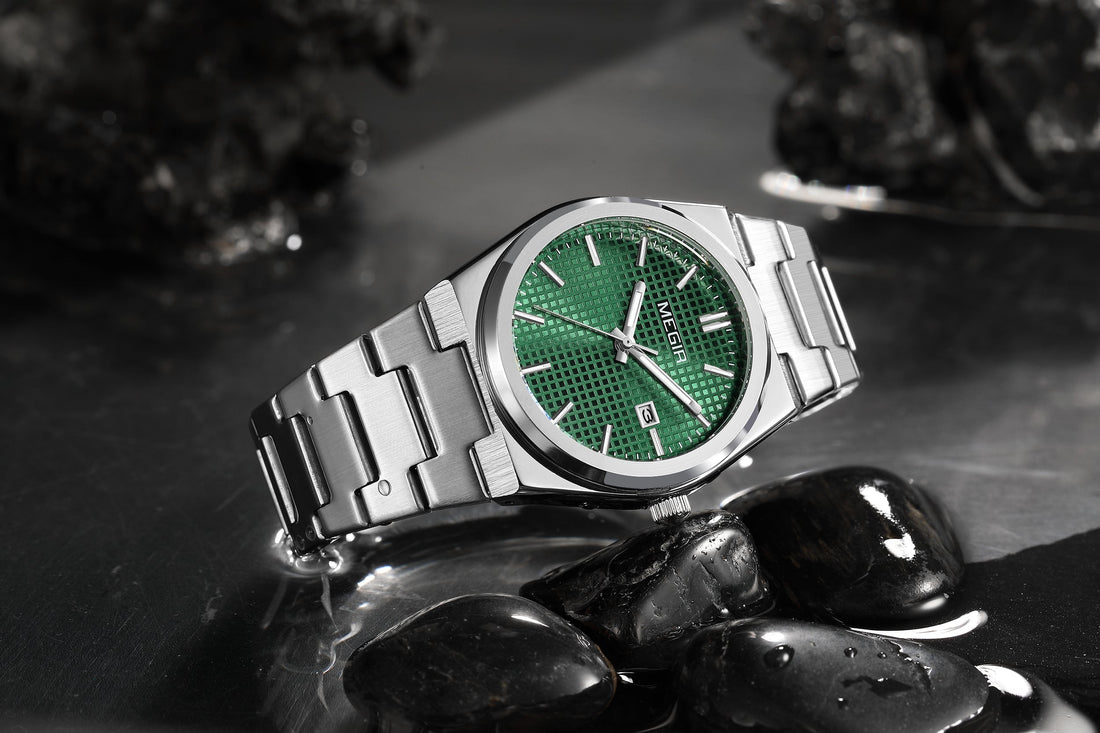
The Green Wave in Watches: What's Behind the Trend?
Share
Have you noticed the quiet green revolution unfolding in the watch industry? From luxury houses to accessible brands, green dials and bezels are appearing with increasing frequency. What is the magic behind this hue, allowing it to break the traditional color codes of watchmaking?
Its popularity stems from a profound transformation driven by color psychology, benchmark branding strategies, practical fashion philosophy, and contemporary culture.
Psychological Motivation: Why Are We Naturally Drawn to Green?
Let's begin with a thought experiment: What comes to mind when you see green?
Is it the first sign of life breaking through the soil, or the tranquil shadows filtering through leaves on a summer afternoon? The moment we think of it, it's as if we are transported to an boundless forest, our bodies instinctively recalling the peace of being embraced by nature—this is no coincidence. Scientific research on the "20-minute park effect" confirms that mere exposure to green is enough to alleviate the anxieties of urban life.
In our fast-paced era, a touch of green on the wrist becomes our "mobile sanctuary"—a pocket-sized nature we can escape to at any time.
Once the psychological links between green and "vitality" or "serenity" became widely recognized, translating this innate emotion into a trend on the watch dial became the key to brand strategy.

Key Drivers: How Benchmark Brands Captured the "Green Mindspace"
No trend emerges without key drivers. The rise of green in the watch world owes much to the precise efforts of several benchmark brands.
Rolex's "Green Submariner" can be considered the starting point of this revolution. Its intensely vibrant green broke the monochrome tradition of black and blue in dive watches. More ingeniously, by controlling production to create scarcity, the brand successfully elevated green from a visual color to a "value symbol" signifying taste and status, igniting strong desire among watch enthusiasts and collectors.
Panerai's "Green Frog" tells another dimension of the story. Its bronze case develops a unique patina with wear, giving each watch its own unique life narrative. Even more masterfully, the brand drew on its legendary history with the Italian Navy to inject an "explorer" gene into green. The limited-edition strategy—the finishing touch—not only created exclusivity but, on a deeper level, provided each wearer with a personal, evolving life record, extending the epic of "adventure" from brand history into personal experience.
The tremendous success of these iconic works sent a clear signal to the entire industry: green had become a new synonym for taste and individuality.
Practical Appeal: Why Green is a Top Choice for Everyday Wear
The finest design remains a window display if it cannot integrate into daily life. The success of green watches lies precisely in their exceptional practicality and versatility.
Consider these scenarios:
Could a touch of green on the wrist help you refocus during a tedious meeting?
Might it elevate your overall outfit on a weekend outing?
In practical styling, green demonstrates remarkable versatility: paired with basic black, white, or grey, it becomes the perfect accent; combined with blue or khaki, it creates a retro or outdoor style. This diversity makes it a standout choice for everyday wear.
Furthermore, this shade of green transcends mere decoration. During wearying work hours, it offers a moment of visual rest, aiding calm and concentration. It is no longer just a collectible stored in a watch box, but a practical accessory that injects natural vitality into daily life and enhances personal style identity.

Cultural Mirror: Why Green Reflects Our Current Values
The popularity of green watches serves as a precise mirror of contemporary lifestyles and shifting global values.
From the ongoing implementation of the Paris Agreement to the comprehensive rollout of the EU Green Deal and the deepening of China's "Dual Carbon" strategy, robust environmental policies are reshaping public awareness. Simultaneously, lifestyle philosophies like the Nordic concept of "Lagom" (just the right amount), Japan's "Wabi-sabi" aesthetics, and the increasingly mainstream "green consumerism" together form a new global cultural landscape.
Against this backdrop, a touch of green on the wrist becomes a silent declaration. It communicates the wearer's empathy with the environment. It no longer merely tells time—it signifies a modern way of life and a sense of spiritual belonging. It responds to both the global awareness of environmental protection and the deeper need for personal expression and identity.
The prevalence of green in the watch world is no accident; it can rightly be called a meticulously orchestrated color revolution. It successfully merges humanity's yearning for nature, the value propositions of brands, and the environmental consciousness of our era.
Therefore, the true magic of this wristborne green perhaps lies in this: it transforms the most personal aesthetic choice into a collective statement of values. The next time you choose a watch, consider a green model. It will do more than tell time—it will speak your attitude towards this era. After all, isn't what you choose also a reflection of the world you wish to see?